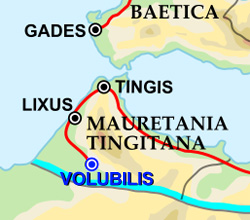Volubilis
Volubilis is an ancient Roman city located in what is now Morocco, near the city of Meknes, and commonly considered as one of the most important archaeological sites in North Africa. The city was originally developed as a Phoenician settlement before falling under Roman control, where it grew significantly in size and importance, primarily due to its location on fertile agricultural land and its role as a center for trade and administration in the region.
History[edit | edit source]
The earliest history of Volubilis dates back to the 3rd century BC when it was a Carthaginian settlement. Following the fall of Carthage, Volubilis came under the control of the local Berber kingdom of Mauretania. It was during the Roman period, particularly from the 1st century AD onwards, that Volubilis saw its peak, serving as the administrative center of the Roman province of Mauretania Tingitana. The city was adorned with many fine buildings, including a basilica, temples, and a triumphal arch.
After the fall of the Roman Empire, Volubilis continued to be inhabited for several centuries, transitioning through the Byzantine and Islamic periods before being abandoned by the 11th century in favor of nearby Fes. The ruins remained largely intact, which has allowed for detailed archaeological studies and conservation efforts in modern times.
Archaeological Site[edit | edit source]
Today, Volubilis is recognized for its well-preserved archaeological remains, which offer a glimpse into the urban fabric and daily life of a classical Roman city. Key features of the site include:
- The Triumphal Arch of Caracalla, erected in 217 AD to honor the Roman Emperor Caracalla.
- The Basilica and Capitolium, central to the city's religious and civic life.
- A number of luxurious villas with beautiful mosaic floors depicting mythological and everyday scenes.
- The Forum, which served as a public square and marketplace.
Preservation and UNESCO World Heritage Site[edit | edit source]
Volubilis has been a UNESCO World Heritage Site since 1997, recognized for its outstanding value as an example of a Roman colonial town on the fringes of the Empire. Preservation efforts have been ongoing, with both Moroccan authorities and international organizations working to protect and restore the site. Despite challenges, such as looting and natural degradation, Volubilis remains a key attraction for scholars and tourists alike, offering insights into the Roman world and its interaction with indigenous cultures.
In Popular Culture[edit | edit source]
Volubilis has captured the imagination of many and has been featured in various forms of popular culture, including literature and film. Its striking ruins provide a picturesque backdrop that continues to attract artists and photographers from around the world.
See Also[edit | edit source]
Search WikiMD
Ad.Tired of being Overweight? Try W8MD's physician weight loss program.
Semaglutide (Ozempic / Wegovy and Tirzepatide (Mounjaro / Zepbound) available.
Advertise on WikiMD
|
WikiMD's Wellness Encyclopedia |
| Let Food Be Thy Medicine Medicine Thy Food - Hippocrates |
Translate this page: - East Asian
中文,
日本,
한국어,
South Asian
हिन्दी,
தமிழ்,
తెలుగు,
Urdu,
ಕನ್ನಡ,
Southeast Asian
Indonesian,
Vietnamese,
Thai,
မြန်မာဘာသာ,
বাংলা
European
español,
Deutsch,
français,
Greek,
português do Brasil,
polski,
română,
русский,
Nederlands,
norsk,
svenska,
suomi,
Italian
Middle Eastern & African
عربى,
Turkish,
Persian,
Hebrew,
Afrikaans,
isiZulu,
Kiswahili,
Other
Bulgarian,
Hungarian,
Czech,
Swedish,
മലയാളം,
मराठी,
ਪੰਜਾਬੀ,
ગુજરાતી,
Portuguese,
Ukrainian
Medical Disclaimer: WikiMD is not a substitute for professional medical advice. The information on WikiMD is provided as an information resource only, may be incorrect, outdated or misleading, and is not to be used or relied on for any diagnostic or treatment purposes. Please consult your health care provider before making any healthcare decisions or for guidance about a specific medical condition. WikiMD expressly disclaims responsibility, and shall have no liability, for any damages, loss, injury, or liability whatsoever suffered as a result of your reliance on the information contained in this site. By visiting this site you agree to the foregoing terms and conditions, which may from time to time be changed or supplemented by WikiMD. If you do not agree to the foregoing terms and conditions, you should not enter or use this site. See full disclaimer.
Credits:Most images are courtesy of Wikimedia commons, and templates, categories Wikipedia, licensed under CC BY SA or similar.
Contributors: Prab R. Tumpati, MD






